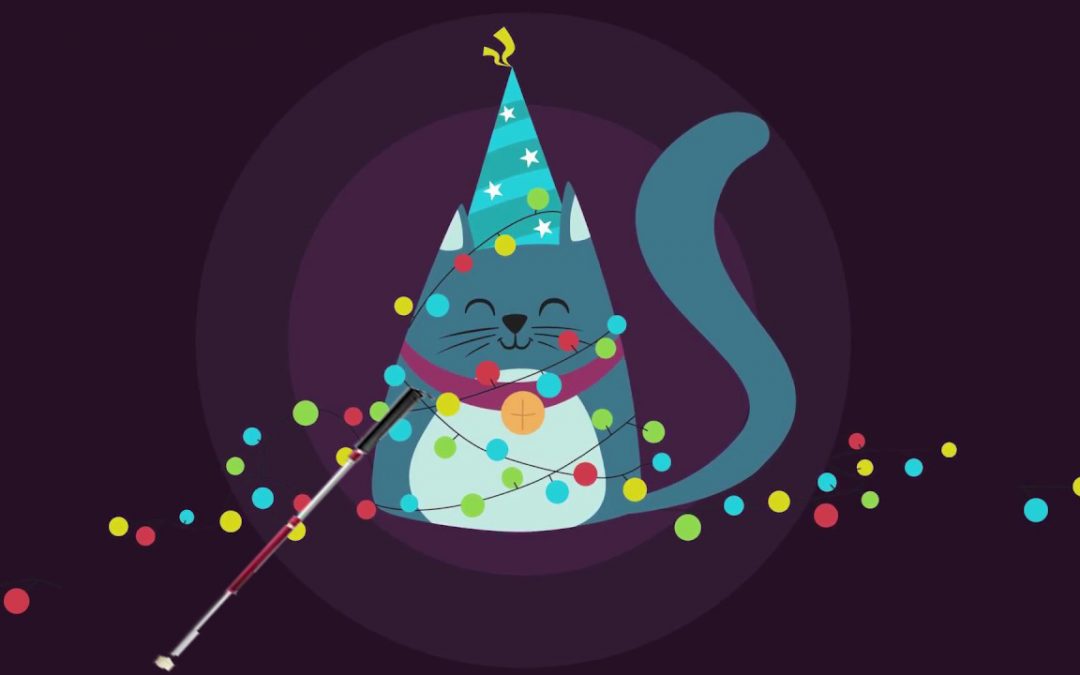
by admin | Dec 16, 2019 | Blog, News
‘Tis the season of holiday get-togethers. How to include people who are blind or have low vision, and help them feel comfortable at these events?
• Always introduce yourself by stating your name when you meet. Encourage other people to do the same. Avoid asking the person “Who am I?” type questions, as guessing games can be embarrassing and uncomfortable. Not all people with vision loss are able to tell others apart by their voices!
• Calling the name of a person with vision loss is like making eye contact with a sighted person. Touch their arm or shoulder lightly as you do so, to be sure they know you are addressing them
• When you are with a person who is blind or has low vision, and you greet someone in passing, be sure to greet anyone you meet by name so the student knows who it is.
• Introduce people to one another! When introducing someone to a person who is blind/low vision, it’s helpful to include a description. You may also want to tell them something about what a person’s job is or a friend they have in common.
by admin | Dec 14, 2019 | Blog, News
Losing your sight should not mean losing your favorite hobbies! Read this inspiring story of a hockey player who continues to enjoy the sport, despite losing his sight due to Retinitis Pigmentosa.
Local hockey player joins National Blind Hockey Team
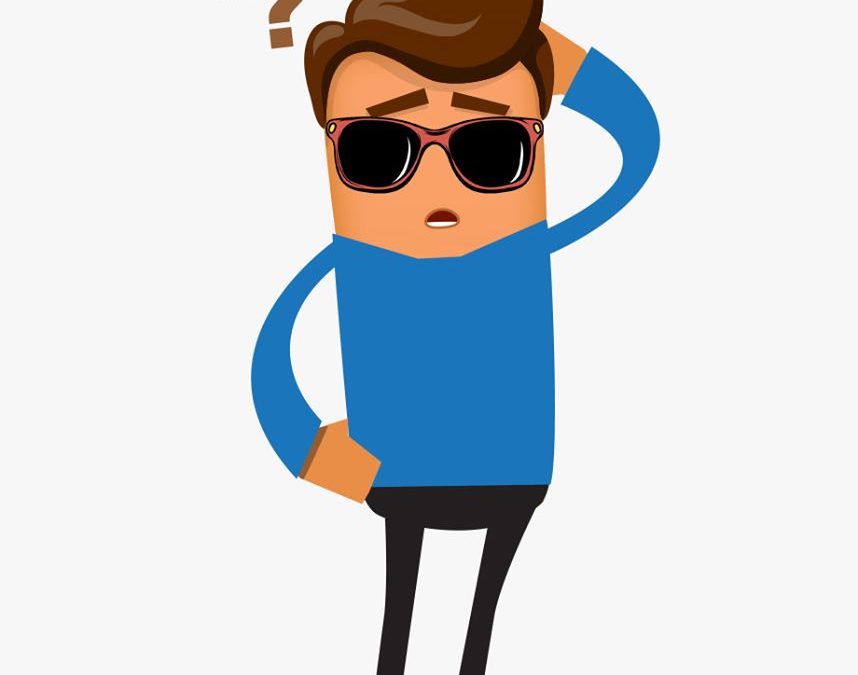
by admin | Dec 12, 2019 | Blog, News
If you are asked to complete a task for someone who is blind or visually impaired, always leave things in the same place you found them! When things are misplaced, it’s much more difficult to find them when you don’t have sight.
by admin | Dec 11, 2019 | Blog, News
Combining virtual reality and a smartphone, IrisVision has come up with glasses that help people overcome many low vision conditions including some of the more common ones like Macular Degeneration, Diabetic Retinopathy, Glaucoma, Stargardt Disease, and Retinitis Pigmentosa.
Learn more about this new technology by clicking the link here.
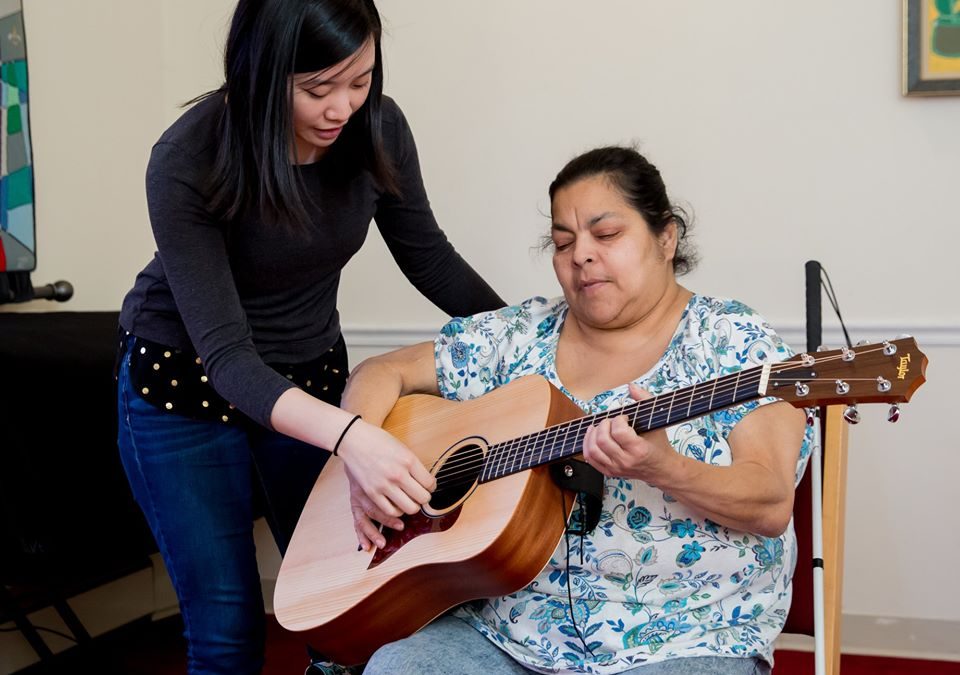
by admin | Dec 10, 2019 | Blog, News
Program Highlight!
Music Appreciation is part of our Health and Wellness Program. In this course, students experience all genres of music and learn to interact with different instruments. Learning to identify sounds and specific instruments will lead to better auditory skills, along with enjoying a world of music and healing.
Added benefit? Enhanced auditory skills help with orientation and identifying traffic patterns!
by admin | Dec 6, 2019 | Blog, News, Uncategorized
Excellent initiative by Target for the holiday season – over 600 of their stores now offer the Aira service for free! Aira service uses a phone app to connect people with visual impairments with an agent who helps guide them through public spaces.
Learn more about the service here.
by admin | Dec 6, 2019 | Blog, News
Did you know arthritis can affect your eyes? Arthritis damages the connective tissue covering the ends of joint bones. This connective tissue is made mostly of a substance called collagen. Collagen is also the primary substance of the eye’s sclera and cornea.
The hallmark of arthritis—inflammation—can lead to vision problems when your eyes are affected. Common eye illnesses stemming from arthritis are glaucoma, uveitis and cataracts.
Many people who have arthritis also suffer from dry eye which, if left untreated, is not only uncomfortable but can lead to infections and corneal scarring.
If you have arthritis and notice the following symptoms, please see an eye doctor – it could save your vision.
•Dry eyes (eyes that burn, itch or feel gritty)
•Continuously red eyes (with blurred vision, pain or light sensitivity)
•Severe eye pain (with light sensitivity, tearing or redness)
Click the link for more detailed information.
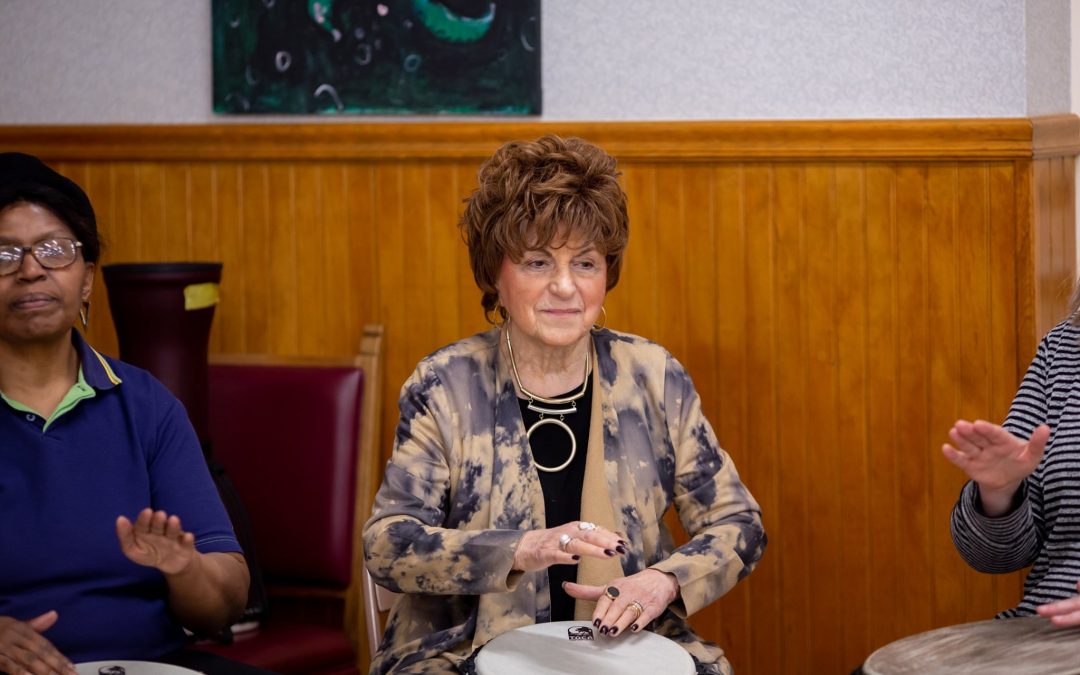
by admin | Dec 4, 2019 | Blog, News
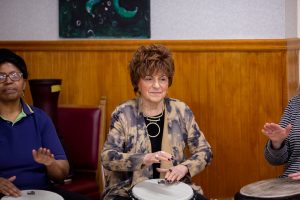 African Drumming Class is offered as part of our Health and Wellness Program. In this class, students learn proper methods of striking the Djembe and Aishiko drums, and the differences between the sounds.
African Drumming Class is offered as part of our Health and Wellness Program. In this class, students learn proper methods of striking the Djembe and Aishiko drums, and the differences between the sounds.
The class fosters an environment of healing and relaxation, and students feel a sense of unity from creating music together. Endorphins and energy are released from the movements, creating a joyful experience for all participants.
Added benefit? Call and response! Students learn to listen and respond with rhythms. A lot of our students have found this class to be especially helpful with learning to navigate traffic, as their echolocation skills become heightened.
Please consider supporting our programs, such as the African Drumming Class, this holiday season. Because when you lose your sight, we help you carry on your vision. Link to donate on our website: www.vlanj.org/donations
Image description: The focal point of the picture is a woman seated in a chair, in the middle of a room, with chairs in the background. She has short, curled brown hair. She is wearing hooped earrings and a geometrical large necklace. She is also wearing a black shirt and a cardigan in beige and blue colors and asymmetrical shape resembling clouds. She is playing a drum with her hands. To her left sits another woman who is drumming. She is wearing a dark blue polo shirt with a light green collar. Her hair is covered with a wrap, and she is wearing glasses and triangle-shaped earrings. Part of another person’s body is visible in the right side of the image. They too are drumming, and they’re wearing a white and black striped shirt.

by admin | Dec 3, 2019 | Blog, News
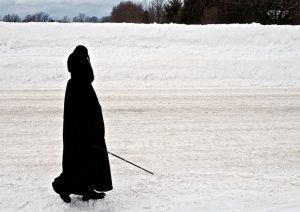
❄️ Snow storms can be dangerous and disruptive. Here are some things to keep in mind about how snow affects people who are blind or have low vision. ❄️
Snow muffles the sounds of things, which can make orientation difficult to persons who are blind or have significant low vision, as they rely on echoes and other sounds to orient themselves to their surroundings. Thus, crossing a street can be challenging because it’s harder to hear sounds of traffic.
Snow interferes with information from white canes – it’s difficult, if not impossible, for cane users to know where they are when the streets are snow covered, as edges of sidewalk and other cues are not readily available.
Snow and ice also cause challenges for people using guide dogs. Salt, although great for getting rid of ice, can hurt a dogs paws, and guide dog owners must take extra precautions to protect their four-legged companions.
How to stay safe if you must go out in the snow:
• take precaution and walk at a slower pace;
• don’t hesitate to ask for help from those nearby;
• bundle up;
• consider alternative methods of transportation such as taxi services.
Stay warm, and safe travels to everyone!
by admin | Dec 1, 2019 | Blog, News
Continuous stress and elevated cortisol levels have been shown to negatively impact the eye and brain due to autonomic nervous system imbalance and vascular deregulation. (Click article link for detailed information)
Glaucoma, for example, is an eye condition damaging the optic nerve, the health of which is vital for good vision. This damage is often caused by an abnormally high pressure in your eye, and the pressure tends to be higher due to elevated cortisol (stress hormone) level.
What can you do about lowering stress? We recommend exercising, doing some yoga and meditating!
At Vision Loss Alliance, we offer several fitness and movement courses for our Health and Wellness Program participants.
Our Yoga class is aimed to help our students:
1. gain balance – when vision loss occurs, since visual cues are no longer available, balance tends to suffer;
2. learn to meditate – to reap all the benefits of quieting one’s mind;
3. get exercise – low-impact exercise is a great way to lower cortisol levels and release endorphins!
Please consider donating to our programs on #givingTuesday, so we can continue to offer programs for the health and well being of people in our community who are blind or have low vision!
by admin | Nov 30, 2019 | Blog, News
Weekends are a great time to relax. Have you considered meditation?
Several studies have shown that meditation can lower intraocular pressure and improve quality of life for people who have glaucoma by lowering stress hormones like cortisol. Click the link for the article explaining the connection.
Here at Vision Loss Alliance of New Jersey, we incorporate meditation into several classes in our Wellness Program. It’s very effective in creating a mind-body connection, lowering stress, and helping with an overall sense of well-being, not to mention the health benefits of lowering eye pressure.
Please consider our nonprofit on #givingTuesday so that we can continue offering a wide array of programs to help people with vision loss and blindness.
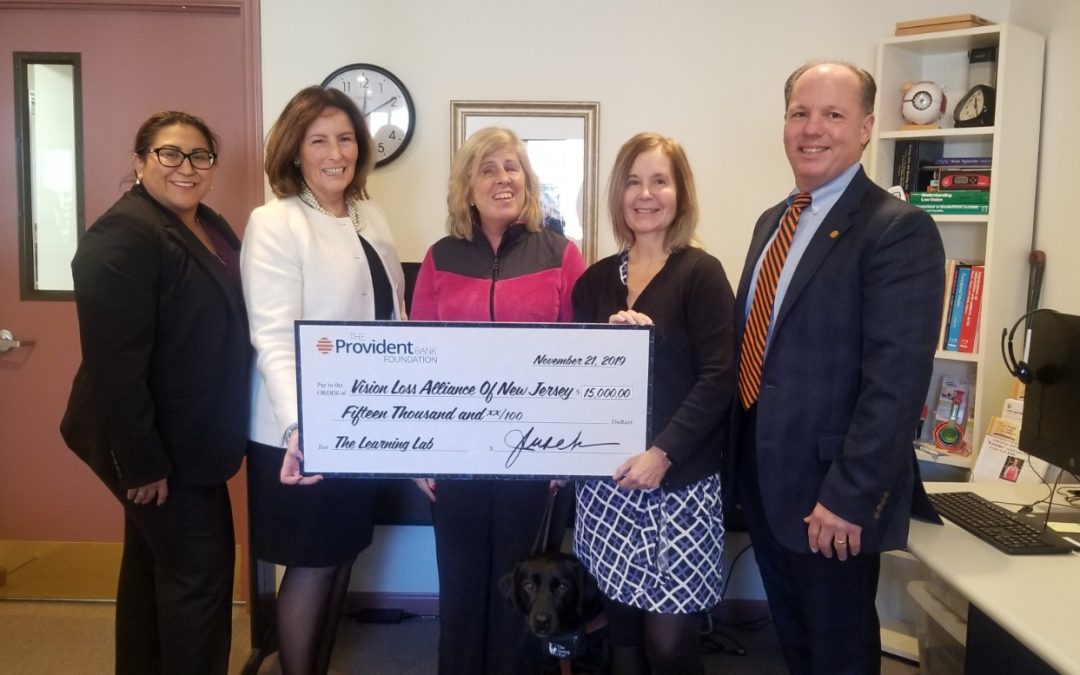
by admin | Nov 25, 2019 | News, Press
Vision Loss Alliance of New Jersey announced it received a Major Grant of $15,000 from The Provident Bank Foundation to support its new Technology Learning Lab.
When it opens in early 2020, the Technology Learning Lab will enhance both the personal and professional lives of people with vision loss. Participants will train on the latest platforms, learning to harness the power of desktop technology, software such as Fusion, and virtual assistants like Amazon Alexa and Google Home.
“We are grateful to the The Provident Bank Foundation for recognizing the value of the Technology Learning Lab and its promise of increasing the independence of people with vision loss,” VLANJ Executive Director Kris Marino said.
A $15,000 Major Grant from The Provident Bank Foundation was presented Thursday to Kris Marino, Executive Director, and Christina Brino, Learning Lab Instructor from VLANJ by Foundation Executive Director Jane Kurek, along with Robert Rocco (VP/Market Manager) and Isis Corris (AVP/Banking Center Manager) of Provident Bank.
“The Provident Bank Foundation is honored to help further initiatives that are making a difference in the lives of residents in our local area,” Kurek said. “We are pleased to support organizations that contribute to a sense of community and offer a diverse set of programs that make people healthier, happier and safer.”
The goal of the Major Grant is to support organizations that have identified an immediate need in the community and for the individuals they serve. The Provident Bank Foundation’s funding directly supports efforts to enhance the quality of life in the New Jersey and Pennsylvania communities served by Provident Bank through three Funding Priority Areas: Community Enrichment, Education, and Health, Youth & Families.
by admin | Nov 24, 2019 | Blog, News
It’s no secret that poor diet is bad for your health. Did you know it can also lead to vision loss? This helpful article explains the link.
Make sure to eat lots of leafy greens, citrus fruits, orange fruits and vegetables, beans and cold-water fish for a well-rounded diet to keep your eyes well nourished!
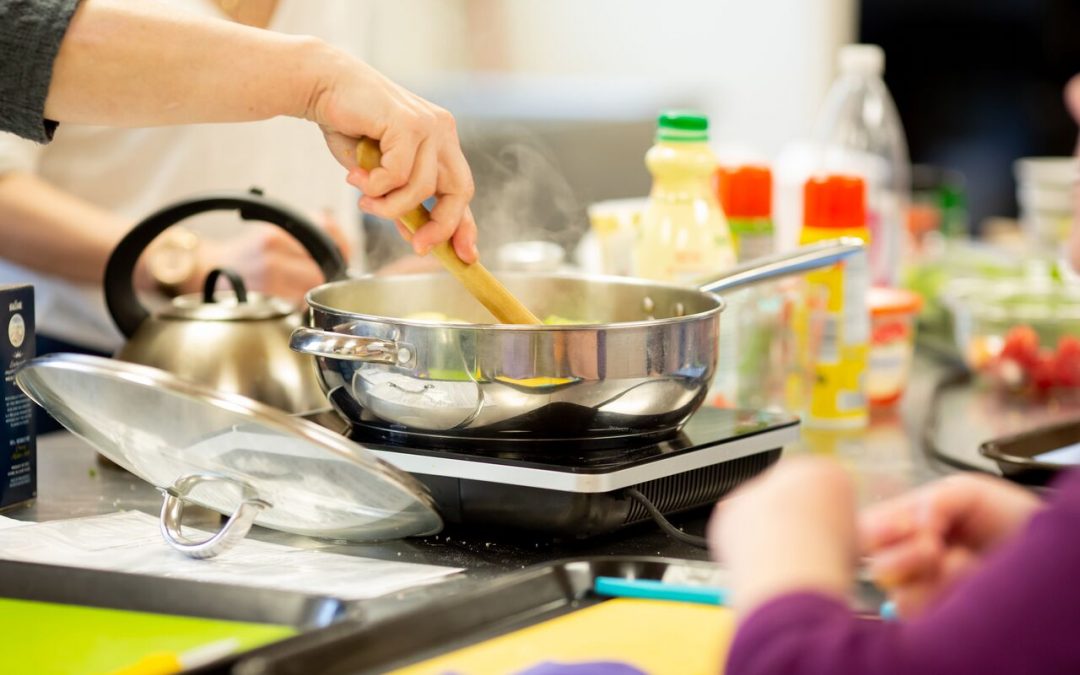
by admin | Nov 23, 2019 | Blog, News
 In our Healthy Options class, students learn how to peel, chop, dice, and puree their way to preparing creative snacks, easy meals and health-conscious desserts by using whole, natural foods & learning about the health benefits they provide.
In our Healthy Options class, students learn how to peel, chop, dice, and puree their way to preparing creative snacks, easy meals and health-conscious desserts by using whole, natural foods & learning about the health benefits they provide.
When vision loss occurs, it’s more likely individuals choose packaged and processed foods simply because they’re easy to prepare and cook. This class aims to offer healthier food options, while teaching short cuts, adaptive strategies, kitchen safety, and use of various kitchen appliances that save time and effort. Students get to work on re-gaining their independence, learn kitchen skills, and get well-rounded tactile experience.
Do you know someone who could benefit from taking our Healthy Options class? Have them get in touch with us for information about our next session!
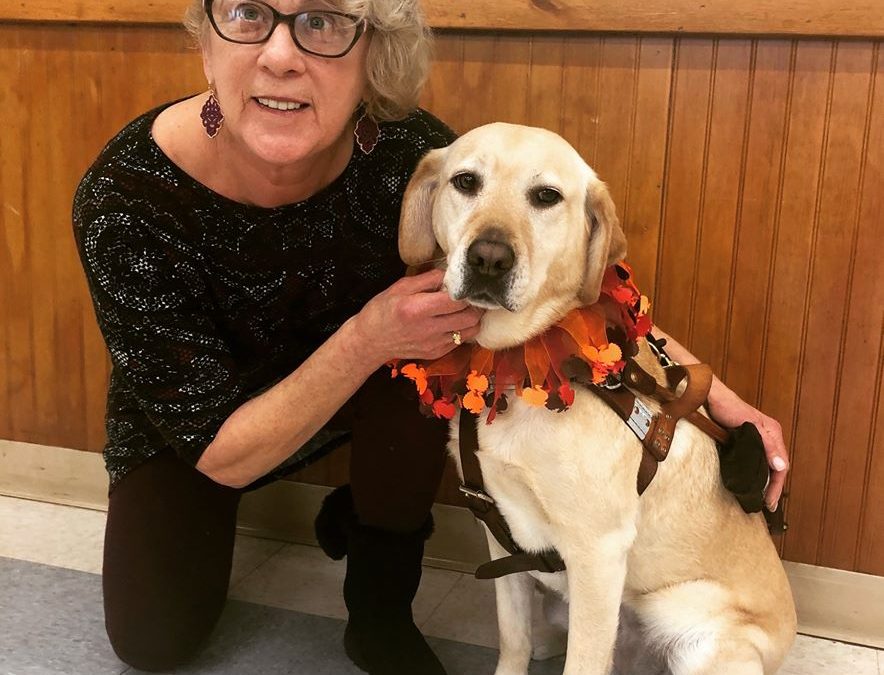
by admin | Nov 22, 2019 | Blog, News
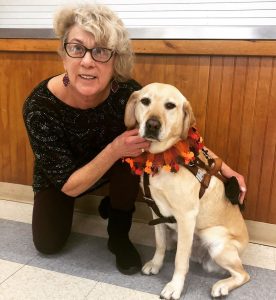 Heather is such a cute puppy, especially in her Thanksgiving outfit that you can’t help but want to pet her… but remember that you shouldn’t! 🐶
Heather is such a cute puppy, especially in her Thanksgiving outfit that you can’t help but want to pet her… but remember that you shouldn’t! 🐶
She is a guide dog, trained by The Seeing Eye, Inc., to keep her owner, Lori, safe. When you see them out and about, Heather is working, and should not be distracted with talk, touch or treats.
Some helpful pointers for when you see a person with a guide dog:
Speak to the handler, not the dog. Some handlers will allow petting, but be sure to ask before doing so. If allowed, don’t pat the dog on the head; stroke the dog on the shoulder area.
If the handler says no when you ask to pet the dog, don’t be offended. The dog (or handler) might be having a bad day, or they might be in a hurry – you wouldn’t be offended if the person said no to you petting their white cane, would you?
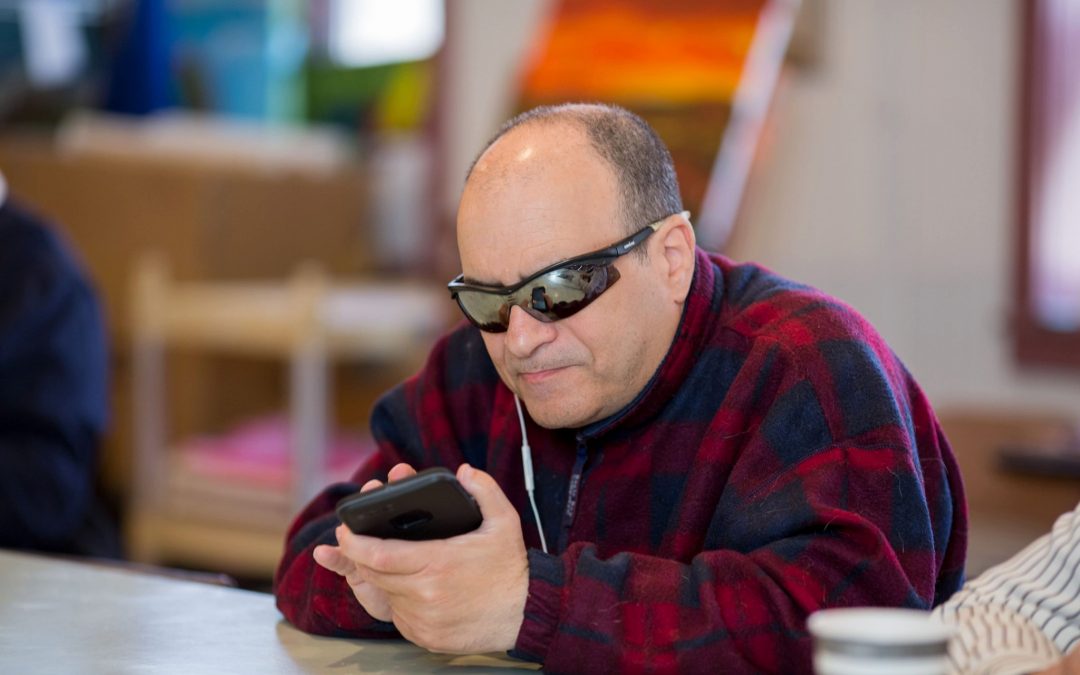
by admin | Nov 19, 2019 | Blog, News
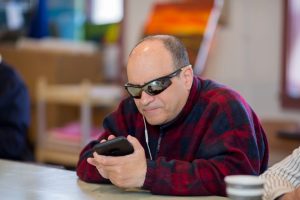
Technology highlight for Tech Tuesday. What is Apple’s VoiceOver?
VoiceOver is a gesture-based screen reader that lets you enjoy using iPhone/iPad even if you don’t see the screen. Hear a description of everything happening on your screen, from battery level to who’s calling to which app your finger is on. You can also adjust the speaking rate and pitch to suit you.
How to set up: In settings, go to “accessibility” and click on VoiceOver at the top. Toggle it to “on”. You can also adjust everything from verbosity to commands.
How to use: With VoiceOver enabled, just triple-click the Home button (or the side button on iPhone X or later) to access it wherever you are in iOS.
Find out more about different types of apps and accessibility features by joining our 13-week Technology Program! Call Linda Groszew at 973-627-0055 ext. 1312.
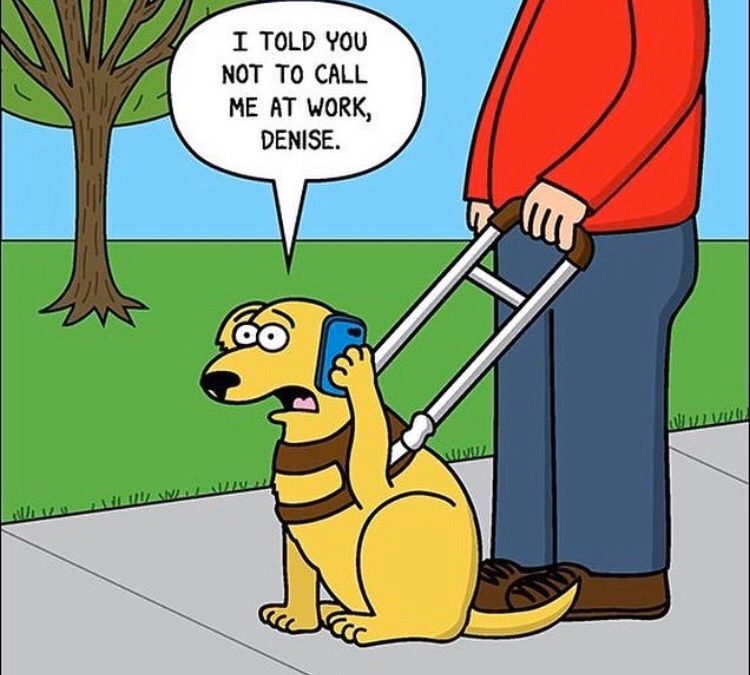
by admin | Nov 15, 2019 | Blog, News
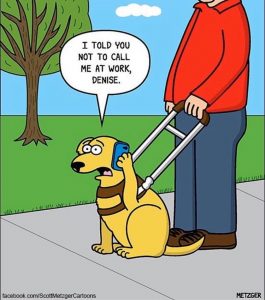
Guide dogs are assistance dogs trained to lead people who are blind and visually impaired around obstacles. They are not pets & are working on keeping their human safe!
Image description: Cartoon of a man in a red shirt, blue slacks and brown shoes holding the handle of a harness of his yellow guide dog. They are outside. The dog answers his cell phone and says “I told you not to call me at work, Denise.”
by admin | Nov 14, 2019 | Blog, News
Have you heard about Amazon Alexa’s new Show and Tell feature? It was developed to help customers recognize household pantry items, such as cans, spices and boxed goods that feel similar to other items and are difficult to identify by touch. Check out this article to find out more about this handy tech tool!
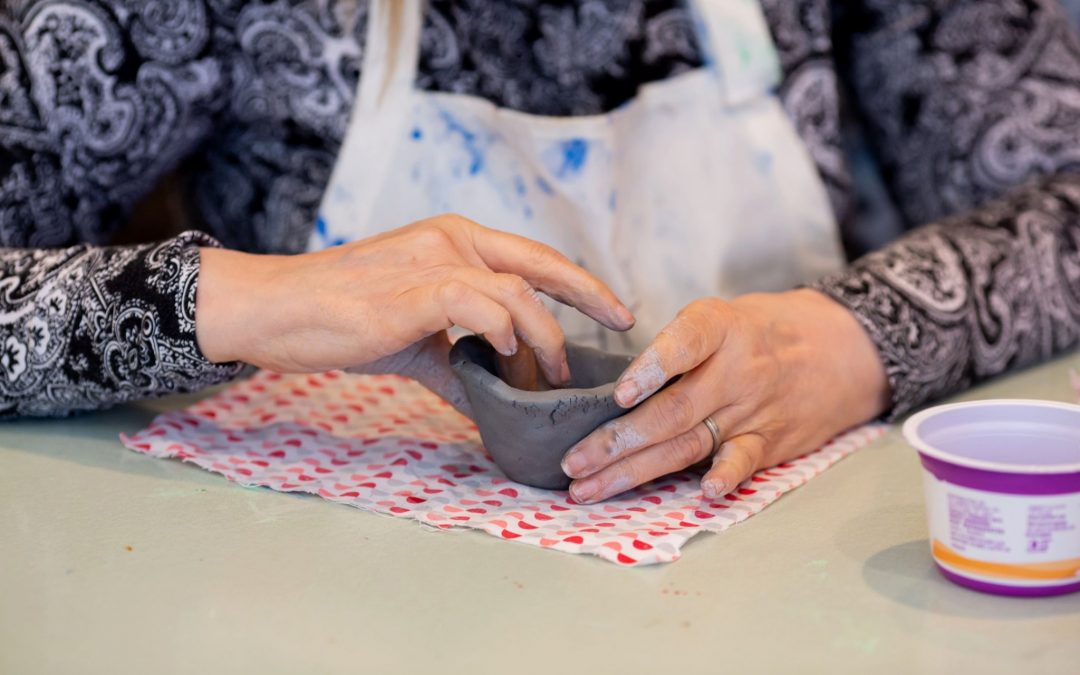
by admin | Nov 13, 2019 | Blog, News
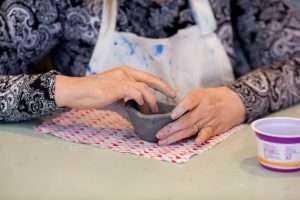
Art Therapy is incorporated into several of our programs. Find out more about the benefits of art therapy here.
One of the classes we offer is Clay Creations, designed to teach the basics of hand-building with clay. Students learn techniques and implements for creating unique pieces, they have an avenue for creative expression, they learn to use their tactile senses, and have a chance to connect with others who have similar interests.
Image description: A woman is seated at a table. Only her torso, arms and hands are visible. She is wearing a black and white, paisley patterned long-sleeve blouse. She has a ring on her left ring finger. She is molding a bowl out of grey clay with her hands. The clay sits on a square of fabric, that has a pattern comprised of red, light grey and pink half-circles. An empty purple and white cup is by the woman’s left hand.
by admin | Nov 12, 2019 | Blog, News
Tech Tuesday find: bionic glasses that may restore vision to some people who are blind!
Bionic Glasses are said to work on patients who still have most of the pathways that enable sight intact — except for their photoreceptors. Photoreceptors are responsible for sending signals to special cells in the back of the eye, which then relay that information via the optic nerve to the brain.
Thus, bionic glasses may become the solution for returning sight to those with macular degeneration and retinal detachment, disorders that cause the destruction of the photoreceptors, but leave the rest of the sensory pathway in tact.
See more in this article!


















